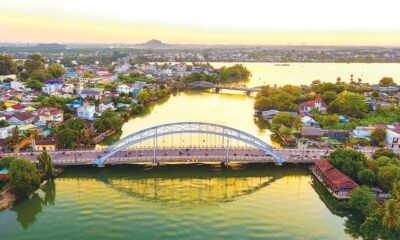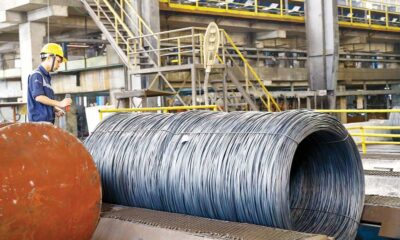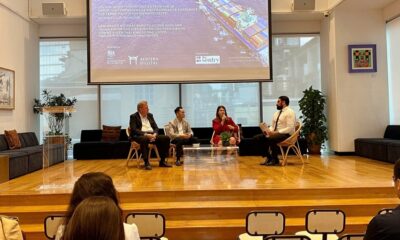Project
All sides must commit to benefits of free, open trade
Published
10 months agoon
Late last year, the United Kingdom joined the Comprehensive and Progressive Agreement for Trans-Pacific Partnership. British Ambassador to Vietnam Iain Frew writes about cooperation prospects across various sectors.
 |
| British Ambassador to Vietnam Iain Frew |
Accession for the UK for the Comprehensive and Progressive Agreement for Trans-Pacific Partnership (CPTPP) is going to provide a boost to both of the UK and Vietnam as businesses see tariffs reduced in a number of areas faster and further, as we see greater opportunities for digital trade and for supply chains, value chains which operate between our countries and the other members.
There are many areas for further cooperation. On the education side, we already have a strong relationship on education between our countries. There are over 12,000 Vietnamese students studying in the UK, and we would love to welcome more. At the same time, we are delighted that so many British education institutions and universities are looking to Vietnam to build partnerships and to offer high-quality services and courses here.
We have seen a number of partnerships develop over the past year, including British University Vietnam and others, offering UK high-quality university level courses to Vietnamese students. Now the UK has the highest number of these partnerships of any country with Vietnam, but we want to see not just quantity, we want to see quality as well.
So we are going to see those partnerships deepen and make sure that not just those who are lucky enough to be able to study abroad can take advantage of this in the UK, but also those who cannot or choose not to travel abroad to study will have access and opportunity here in Vietnam, which is a very important and very large market for many of those institutions.
Boosting healthcare
We have also seen some positive elements on how we are working together on healthcare. This included a delegation of healthcare innovation professionals visiting the UK last year, learning about how our healthcare system is developing and how innovation is supported through universities, businesses, and healthcare providers.
As Vietnam’s population continues to become richer, its demographics continue to shift, and new diseases and healthcare challenges develop, both the private and public sector are having an increasing focus on these issues. So this year we are going to continue to support that path of healthcare innovation.
Vietnam is becoming a place where it is not just British companies selling pharmaceuticals and medicines here in Vietnam, but is developing manufacturing in this sector. It is part of the chain of research, testing and clinical trials that all help to support healthcare innovation, as well as bringing new therapies and treatments to Vietnamese patients and consumers. So I think that is a very exciting area.
Additionally, we are hoping to support Ho Chi Minh City to develop a healthcare innovation hub together with the city of Liverpool and some important institutions such as the Oxford University Clinical Research Unit, based in Ho Chi Minh City.
Cementing tech cooperation
Both Vietnam and the UK have set out ambitious plans for how we are going to take advantage of the technologies of the future, whether that is AI, quantum, bioengineering, etc. These are all areas that, at this stage, are relatively small parts of our economies, but we can see huge potential for how these become important parts of our economic development. We are going to work together really closely on how we build those technologies, how we deploy them, and how we support innovation and entrepreneurs in these areas.
Recently we saw the first edition of the UK Southeast Asia Tech Week, and the second edition will take place at the end of March. That will bring together a range of innovators and businesses coming from the UK to Vietnam, with a focus on AI this year. They will share their expertise and make connections with Vietnamese partners to look at how we can continue to develop the sector between the two countries, alongside a range of other technology opportunities and financing. That has a lot of potential for the year ahead, and I think when we see that milestone in March, we are going to see a lot more develop from that and afterwards.
It would be remiss of me not to mention as well some of the ways in which we’re working together in defence and security. At the end of last year, we participated in the Hanoi Defence Expo, a huge and incredibly impressive event, as well as a celebration of 80 years of Vietnam’s army.
The question of how Vietnam continues to develop its security partnerships, and how it continues to diversify and modernise its defence, is an area where the UK and Vietnam are going to be working closely together. We have seen already through ship visits, through the UK Pavilion at the Defence Expo, and the cooperation between our defence ministries, that there is a lot more that we can do to support Vietnam’s modernisation, its security, and its resilience, as well as partner internationally, for example in UN peacekeeping. We are going to be doing all of that and more.
Intensified agriculture ties
Meanwhile, Vietnam’s agriculture exports have seen British consumers benefit from exports of seafood, which you can find in UK supermarkets – from pomelos and dragon fruit to rice and coffee, all of which are increasing volumes to the UK. The UK is also one of the top 10 markets for Vietnam’s cashew exports, so British consumers benefit hugely from this.
Alongside that, we are seeing increasing export of UK agricultural products to Vietnam, whether that be pork and poultry products, seafood, and whisky, as well as others which are growing their market share, like British cheese, chocolate, and confectionery.
These are all areas that we want to see develop further, and we have already seen some progress so far. Our free trade agreement (FTA), CPTPP, provides a really strong basis for these sectors to go further and faster in the future.
The UK government has announced a big investment and a commitment to building on the potential of AI within our country, but also with international partners, and I want to see us do that together with Vietnam.
But we need to be both committed to the benefits and aware of some of the challenges that are brought by AI, whether that is existing businesses, communities, online safety, and to the broader international frameworks that we operate in. We need to work together to take advantage of that sector and update our regulation, our framework, as we do so.
Another example is in data. Data flows are vital to our economies, and we have to keep data flowing freely, but securely. And those are things we must keep carefully in balance, and I look forward to continuing discussions with Vietnamese lawmakers and regulators about how new laws on data are being applied and how that is affecting businesses. It is necessary to keep a close eye on that, as we do with our frameworks in the UK, modernising them where necessary, and taking advantage of making available opportunities to our consumers and our businesses.
Recommendations
The basis of the trade agreements is also one in which Vietnam consistently sends messages around being an open and predictable trading environment, and that is a message delivered through agreeing on FTAs, but is also about making sure that we keep sectors and markets open and continuing to follow those rules.
For Vietnam to further promote investment and trading relations with the UK, especially when it comes to improvements for businesses of both countries to foster cooperation and utilise the CPTPP, we will work together with the Vietnamese government through our annual trade dialogues and our committees regulating our FTA to ensure that there is a level playing field and an open playing field.
But I am very heartened by the positive message that Vietnam continues to send on open trade, at a time when some countries are doubting commitments internationally to open and free trade, as well as the benefits it brings our consumers and our countries. Our two countries are very committed to those benefits, so that’s something that we should both continue to stay committed to.
At the same time, we need to see both countries continue to benefit from increasing trade and increasing prosperity through modernisation and development of our regulatory frameworks, whether that is around the energy sector, the consumer sector, or new technologies.
We need to build the frameworks to ensure that new technologies are fully regulated, and that we allow businesses and entrepreneurs to take the greatest advantage of the opportunities that are there. And we need to make sure that those technologies develop, and AI is a brilliant example of something we need to pay very close attention to.
You may like
-


UK’s Uppingham School plans to open first Asia facility in southern Vietnam
-


UK Jadestone Energy submits field development plan for gas fields offshore Vietnam
-


Sustaining growth in a volatile global environment
-


Vietnam seeks UK expertise in financial centre development
-


Trade agreements bring significant non-tariff benefits
-


UK in the Bloc: CPTPP expansion benefits all parties
Project
Vietnam’s Exclusive Economic Zone boasts over 1,000 GW of wind power potential: report
Published
8 months agoon
April 27, 2025Vietnam’s Exclusive Economic Zone (EEZ) has a wind power potential of 1,068 GW, nearly 470 GW more than previously estimated, according to a report released Friday by the National Center for Hydro-Meteorological Forecasting (NCHMF).

An offshore wind power project in Vietnam. Photo courtesy of VnEconomy.
The report, titled “Detailed Assessment of Wind Resource Potential in Coastal (up to 6 Nautical Miles) and Offshore Areas in Vietnam,” was conducted by the NCHMF with support from the United Nations Development Program (UNDP) and the Norwegian Embassy.
This wind potential was measured at a height of 100 meters above sea level, said Mai Van Khiem, director of the NCHMF. He noted that from November to February each year, wind capacity accounts for half of the annual total – peaking in December and gradually decreasing, with the lowest levels recorded in May.
The southern offshore areas account for 894 GW of this potential, while the northern areas contribute 174 GW.
In nearshore zones (up to 6 nautical miles), the total technical wind power potential is 57.8 GW. The Bac Lieu-Ca Mau region alone contributes nearly 30% of this, while the Ninh Thuan-Binh Thuan area accounts for 24 GW. Although the Quang Tri-Hue region has lower potential, it offers stable wind speeds during the winter months. The Red River Delta has a modest potential of 0.17 GW.
Compared to previous assessments, such as the World Bank’s 2021 study and data from the Global Wind Atlas (GWA), this report provides more detailed and higher-resolution information, both spatially and temporally.
“Notably, the EEZ potential outlined in this report exceeds the World Bank’s estimate by 469 GW, primarily due to the broader scope of the survey and more refined climate modeling using domestic observational data,” the research team explained.
They also emphasized the use of the Weather Research and Forecasting (WRF) model customized specifically for Vietnam, which enhanced the accuracy of the results.
The findings are based on wind data collected from 26 coastal and island meteorological stations, satellite sources from CCMP, ASCAT, and SCATSAT-1 (covering 30 years of ocean surface wind data), as well as buoy data from Nghe An province and seabed depth measurements.
A key innovation in this report is the integration of potential impacts from extreme weather events. Typhoons and tropical depressions occurring between August and October pose structural and safety risks to wind turbines. Meanwhile, strong winds and high waves during the northeast monsoon season can hinder access to and maintenance of offshore wind systems.
To support model calibration and long-term observation, the research team recommends increased investment in offshore wind monitoring stations at heights exceeding 100 meters. They also suggest incorporating these findings into offshore wind development strategies and national marine spatial planning.
Additionally, the team advocates for expanding research into other forms of marine renewable energy, such as wave, tidal, and ocean thermal energy.
“Vietnam has some of the most promising offshore wind resources in the region, creating a strong foundation for the development of a large-scale offshore wind industry. This will contribute to energy security, green economic growth, and the achievement of net zero commitments,” they said.
The study provides a vital scientific basis for policy planning, identifying priority development zones, attracting investment, building infrastructure, and training the future offshore wind workforce, the team added.
Hoang Duc Cuong, deputy director of the Department of Meteorology and Hydrology, emphasized that Vietnam lies within a strong and stable Asian monsoon belt, giving it abundant wind energy potential. He noted that this renewable source will play a key role in meeting the country’s climate change goals and advancing a low-carbon economy.
However, he also warned that marine-based natural disasters are highly complex and could significantly impact the stability of offshore wind operations and energy generation.
The ever-changing status of the global economy following last week’s tariff shocks continue to loom large among investors in Vietnam’s real estate market.
 |
| All real estate segments are at risk of losing appeal if high global tariffs are eventually put in place, photo Le Toan |
Pham Lam, vice chairman of the Vietnam Real Estate Association, said that while it is premature to determine the full impact of new US import tariffs on Vietnam’s property market, early signs point to shaken investor sentiment and potential disruptions to foreign investment.
“If multinational corporations scale back or delay their factory expansion plans, the demand for land and factory leasing could decline, which may place downward pressure on industrial rents, lead to increased vacancy, and postpone new industrial zone developments,” he said. “This would affect key industrial property markets such as Bac Ninh, Bac Giang, Haiphong, Long An, and Binh Duong.”
Meanwhile, real estate expert Nguyen Hoang said that the United States remains one of the most critical export destinations for Vietnam’s foreign-invested enterprises.
“Any change in tariffs will significantly influence capital flows, investor confidence, and manufacturing strategies of companies operating in Vietnam. If a high tariff is fully implemented in 90 days, it could seriously diminish Vietnam’s investment appeal – affecting all real estate segments as a result,” Hoang said.
Vietnam’s property market has only recently emerged from a prolonged two-year downturn.
“It remains highly sensitive to economic and policy shocks. Investors have remained cautious, and any further external pressure could threaten to break the fragile liquidity recovery, potentially sending the market back into a period of short-term stagnation,” Hoang added.
Alex Crane, managing director of Knight Frank Vietnam, said that the recent tariff twists by the US casts a shadow of uncertainty, with potential implications for various segments of the market.
While manufacturing has shown resilience, it is still on the path to full recovery from the pandemic, particularly in labour-intensive sectors like garments and furniture. Tariffs imposed now would not have as severe an impact as they might have during Vietnam’s 2019 peak, but consequences are still expected, Crane said.
“I may expect that major transactions, especially those involving large capital outlays, are being paused or undergoing extended due diligence as investors and developers reassess assumptions and underwriting models and commercial occupiers are expected to defer large capital expenditures in the short term,” Crane said.
In addition, the response from the State Bank of Vietnam, particularly regarding monetary policy, will be crucial. While a rate cut may not effectively stimulate residential demand (as demonstrated in 2024), targeted lending for key industries and easing of loan-to-value ratios or debt-to-income limits for developers could provide relief.
“At present, most segments of the real estate market are in a holding pattern, awaiting clarity from the evolving negotiations between the Vietnamese and US governments. While uncertainty is unsettling, Vietnam’s underlying fundamentals remain sound, and the market’s long-term outlook is still viewed positively,” he added.
Nguyen Dung Minh, deputy CEO of MIK Group, has warned that under the new US tariff regime, many investors will be forced to reassess their strategies, likely leading to a decline in the demand for industrial land.
“Investors will need time to re-evaluate their actual demand and incoming orders and make necessary adjustments before they can fully gauge the extent of the impact,” Minh said.
He added that the implications go beyond just industrial land. “The new US tariffs are also expected to disrupt supply chains and negatively affect supporting sectors such as logistics, warehousing, and raw materials manufacturing. As production slows, so too will the demand for land associated with these services,” Minh said.
| Trang Bui, country head Cushman & Wakefield Vietnam
While the effects of tariffs are typically delayed, most economists warn that they may eventually fuel inflation and dampen economic growth. Many manufacturing firms could opt to postpone their expansion plans in the short term if export duties become too burdensome. There is also a possibility that some companies may look to diversify their supply chains towards a Vietnam+1 model, shifting parts of their operations to neighbouring countries. This could lead to a decline in demand for factories and warehouse leasing, two key drivers of the industrial real estate segment. However, it is important to recognise that industrial real estate is fundamentally a long-term investment. Vietnam has long positioned itself as the manufacturing hub of Southeast Asia, thanks to its strategic location and the “bamboo diplomacy” approach, which has enabled the country to swiftly join trade negotiations and sign multiple free trade agreements. Moreover, many manufacturers in Vietnam have already established tightly integrated supply chains. As such, their investment plans tend to operate on a much longer time horizon than the near-term effects of tariff policy. Relocating supply chains typically requires at least 3–5 years, making short-term shifts less likely. Overall, Vietnam’s industrial real estate sector has proven resilient under various political and economic conditions. Investors would do well to focus on long-term trends and structural advantages. Manufacturers, in particular, may take this opportunity to secure high-quality industrial assets, invest in automation, and pull in skilled labour, while continuing to monitor developments in upcoming trade negotiations with caution. Nguyen Thi Bich Ngoc, CEO, Sen Vang Group When it comes to the reciprocal tariff policy announced by the US, the greater danger currently lies not in the tariff itself, but in the heightened sense of uncertainty it has triggered across the Vietnamese market, a sentiment clearly reflected in recent VN-Index fluctuations. In the short term, the policy will weigh heavily on Vietnam’s industrial real estate sector. However, in the long run, this challenge could serve as a catalyst for stronger growth. It presents an opportunity for the government and industrial zone developers to rethink their strategies, offering more competitive, attractive solutions to both foreign and domestic investors. Rather than relying solely on external trends like the China+1 shift, Vietnam should leverage its inherent competitive advantages, including a strategic geographic location, a skilled and cost-effective labour force, and political stability, to pull in long-term investment. These are undeniable strengths that set Vietnam apart. Moreover, this is also an opportune moment for Vietnam to re-evaluate and restructure its key sectors, prioritising strategic industries with high growth potential. Continued engagement in bilateral and multilateral trade agreements will open up new opportunities and elevate Vietnam’s position both regionally and globally. Ultimately, we must seize this challenge as a turning point, transforming pressure into momentum for sustainable development. Vo Hong Thang, Investment director DKRA Group The industrial infrastructure, commercial, and residential real estate segments are all likely to face increasing headwinds if a huge tariff increase is eventually implemented. In recent years, a number of developers have made significant investments in industrial zones, betting on a continued influx of foreign direct investment. However, the new tariff policy raises the possibility of such flows being diverted to other countries. Vietnam now faces the risk of having built the nest, but being unable to attract the eagle. In addition, liquidity in both residential and commercial real estate, including retail, office, and hospitality, is likely to weaken in the short term due to more cautious investor sentiment, defensive capital flows, and reduced purchasing power from end-users. Niche investment segments such as serviced apartments, tourism-related accommodations, and foreign buyer housing could also see demand drop, particularly as the foreign expert and executive workforce, typically a key demand driver, scales back plans to live and work in Vietnam. |
Project
Central Vietnam city seeks $1.84 bln for 15 projects in economic zone
Published
8 months agoon
April 26, 2025Authorities of Hue city in central Vietnam have released a list of 15 projects in Chan May-Lang Co Economic Zone which will need VND47.5 trillion ($1.84 billion) in investment capital between 2025 and 2026.

Chan May-Lang Co Economic Zone in Hue city, central Vietnam. Photo by The Investor/Dinh Duy.
Notable projects include the Chan May non-tariff zones No. 1 and 2 infrastructure development project, with a total area of over 503 hectares and combined investment capital of VND2.8 trillion ($108.23 million).
Another is the VND20 trillion ($773 million) Chan May Urban Area project (locations 1 and 2), which will cover 225 hectares and be implemented over five years.
The LNG terminal project at Chan May Port, 27 hectares with an investment of VND8.6 trillion ($332.43 million), is set for five-year implementation.
The 120-hectare Bai Ca eco-tourism project in Lang Co township will have investment capital of VND2.5 trillion.
The Lang Co beach resort, with an area of 45 hectares and total investment of VND4 trillion ($154.62 million), will be carried out over five years; while the 75-hectare Lap An lagoon tourism, urban development and resort complex in Lang Co township will cost VND6 trillion.
According to the management board of Hue Economic and Industrial Zones, since its establishment, Chan May-Lang Co Economic Zone has attracted 55 investment projects which remain valid, with total registered capital of VND97.32 trillion ($3.76 billion).
Among these, 15 are foreign-invested projects with combined capital of VND56.02 trillion ($2.17 billion), accounting for 57.56% of the total.
Several prominent foreign investors have established a presence in the zone, such as Banyan Tree Group (Singapore) with the Laguna Lang Co Resort and Winson Group (Taiwan) with the Billion Max Vietnam Export Processing Factory.
Chan May-Lang Co has become a destination for investments in sectors like tourism and resort development; seaport infrastructure; logistics; clean industry; and high-tech, environmentally friendly industries, with annual revenue reaching nearly VND4 trillion ($154.62 million) and tax contributions of around VND300 billion.
The management board said Hue city has proposed the Ministry of Construction review the adjustment of the EZ master plan through 2045, for submission to the Prime Minister.
The strategic goal is to develop Chan May-Lang Co into a key economic zone of central Vietnam – a coastal gateway offering logistics services for the central region and the East-West Economic Corridor, as well as a hub for high-end tourism services.
To attract investors, the local government will offer a range of incentives such as a 10% corporate income tax rate for 15 years from the first year the project generates revenue; import tax exemption for goods to create fixed assets for investment projects, and land and water surface rental exemptions, the board said.

Bac Giang International Logistics Centre launched

Vietnam’s Exclusive Economic Zone boasts over 1,000 GW of wind power potential: report

Uncertainty weighing on real estate

Central Vietnam city seeks $1.84 bln for 15 projects in economic zone

